In conversation with the world
Three poems & an interview with Vivek Narayanan, by Leeya Mehta
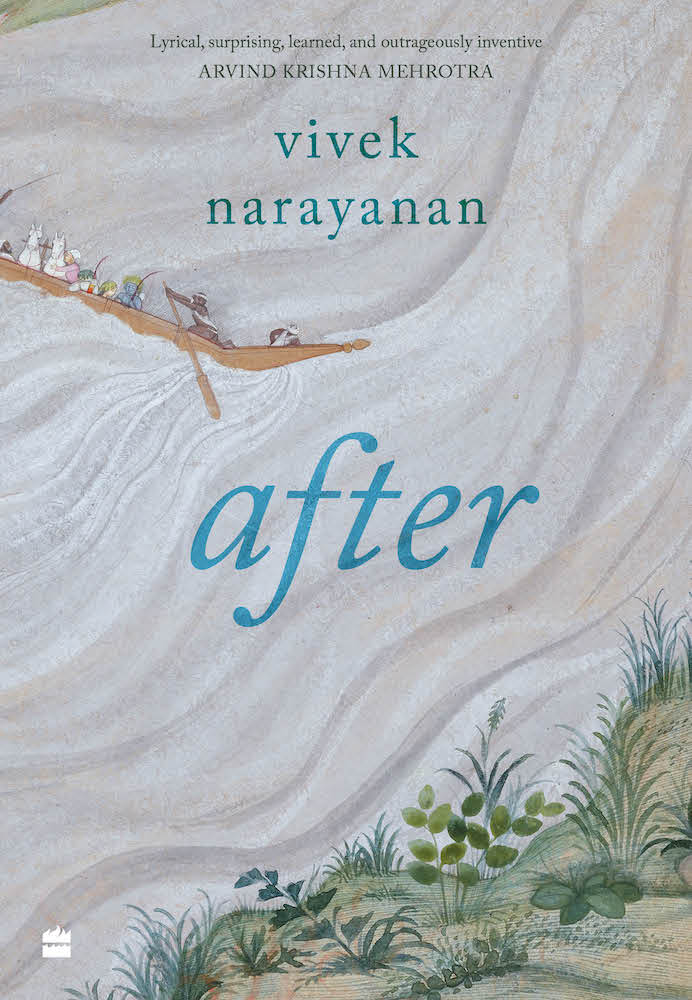
“My theory is that political poems help us capture and
hold these contradictions in a productive tension. I
believe the wildness of poetry is its greatest political
asset.” – Vivek Narayanan
Vivek Naryayanan’s After is a collection of poems inspired by Valmiki’s Ramayana. It is a postmodern collection of poetry that reflects on the relationships between duty, power, patriarchy, perception, and imperfection. The epic Ramayana has hundreds of versions in old and new languages; and has been captured in myriad forms of popular culture. But even today, it is a story cycle with old and new lives existing in parallel. Vivek Narayanan’s genius wrestles with all these lives to create a masterpiece pulsing with blood, whose origins reveal the remarkable interconnectedness of our cultural DNA as humans. And as fascinating is the way his poems convey how our human DNA is interwoven into the natural world, with shape shifters and simians fighting beside Rama for Sita’s return to Ayodhya.
It has been said of After that it warrants comparison with Christopher Logue’s and Alice Oswald’s reshaping of Homer. And there it stands as a cosmopolitan yet rooted, act of inspiration. The life of the poet himself, of Narayanan, has its own particular biography that shows the reach of the epic. He is a more global poet than most, having spent many years in Zambia, India, and America. To such a global poet the limits of continents and spaces are both tangible and also like the simians of the Ramayana, that move swiftly across land and water; a feat of imaginative acrobatics. But it is his art that gives the movement form, story, beauty, and that is where Narayanan triumphs. His poems are crafted to exist outside of the epic, to transcend it completely, which is why they cannot be limited to being called translations.
As a child growing up in a cosmopolitan society in Mumbai, I came to see the diversity of epics milling around from The Odyssey to the Ramayana, as mine to open and look within. The Ramayana was also serialized in Amar Chitra Katha comics for kids. The plot was “epic,” as children use the word today, jaw dropping in fact, what with Ram’s banishment, his wife Sita kidnapped by the demon king Ravana to Lanka, and a war that leads to Sita’s great rescue.
In 1987 a television serial on Rama’s story was watched by 650 million people. Villages that had just one TV aired it in communal showings. In the early 90s, I did English voiceover for a Japanese animated version of the epic. What struck me then was how this was not just an Indian epic from the late bronze age, but a form changer, a maverick that belonged outside India. Just like the languages that seep through the vast subcontinent in a constant state of flux for hundreds of years, we were participating in a process of human beings giving and taking culture. The Ramayana is world literature, it is pop culture, so what if it is more than two millennia old.
Vivek Narayanan delivers Rama’s existential struggle to attain greatness, even in imperfection. He re-imagines the Ramayana in all its facets of victory and tragedy, taking the reader into those parallel worlds that are contemporary India. The India that is millennia old, and the one that resides in the streets. By so doing, he layers us into contemporary consciousness in a way that is more akin to how we live than any work of art I have engaged with recently.
Over a series of conversations with Narayanan about After, we decided to focus on some of the questions I had about the hundreds of Ramayanas and the multitudes from which the Ramayana was re-told and continues to prosper. The poet Vijay Seshadri explains how After “is a conception in English” of Valmiki’s Ramayana, yet “a liberation of it.”
Leeya Mehta: You have said that “this is a text of world literature, where every reader makes it their own.” What do you mean by that?
Vivek Narayanan: To be honest, what I’m reacting to in the first place is the annoying and still persistent tendency in Anglo-American poetry worlds to universalize the Greco-Roman classical tradition and exoticize all the others. (This is a pity on so many levels, not least because all the various classical traditions—for instance, from the Mediterranean, through Egypt and Ethiopia, through the Middle East, through Persia, the Indian Subcontinent and China were, for thousands of years, far more in conversation than we even understand.) I’ve come across highly sophisticated US poetry readers who seem to be intimidated by the Ramayana: they find my book “culturally challenging” or somehow feel they have to prepare for it, “educate” themselves before they even start reading. Strangely, no one ever says that about the Iliad or the Odyssey, although those worlds are arguably as distant from ours as the Valmiki is.
On the other hand, in my Ramayana class at George Mason, I’ve seen undergraduates from all backgrounds learn how to just fall into the text and eventually make it their own, tell their own unique versions, first as readers then as unconscious writers, and in that process of falling in, the work begins to open up its secrets and enduring mysteries, and each new reader often brings astonishingly new insight, drawing on who they are.
And certainly, I believe the Ramayana and the long Ramkatha [“Ram story”] tradition does, in its nature, allow that room for any kind of reader/writer. As you know, this epic exists today in countless, even uncountably, different versions, all across South and Southeast Asia and beyond, so much so that it has been said there is no Ramayana as such, except for the variousness of those versions.
This effect I think is partly because of its long probable evolution in the subaltern oral bardic tradition, where it would have developed all kinds of dazzling wrinkles and ways of telling. But what’s also interesting is that in the Sanskrit written version that was my main source, probably the oldest complete and extant Ramayana, there may still have been a desire to capture some of that, because so often it felt to me like multiple versions and ways of reading were just sitting on top or sometimes adjacent to each other.
In this way, the epic has migrated across every possible border you can imagine, translating and reinventing across artistic mediums, oral and written, languages, cultures, geographies. We should be clear that the Ramayana does not belong to any one nation or religion. It was equally if not more important to the early Buddhists and Jains as it was to the various Vedic-aligned sects; it’s via Buddhism that news of the epic and the first translations go into Chinese, as early as the 5th century A.D. And from at least the 16th century onwards there is an incredibly rich tradition of Ramayanas composed by Muslims, both the elite writing in Persian and in the folk tradition of groups like the Mappila Muslims of Kerala. Thai or Balian or Indonesian versions of the Ramayana are not “peripheral” but visionary relocations of the tradition that produce innovative possibility because of new contexts. Everywhere the Ramayana goes, it integrates and reinvents with local story and with place.
So for all those reasons, I really do believe the Ramayana should be claimed and read by all as world literature, and I develop this further in After, by putting the Ramayana in direct and hopefully meaningful conversation with a very wide variety of sources from around the world, whether ancient, modern or contemporary.
LBM: When you began this project, Vivek, what was it that surprised you the most?
VN: As you know the Sanskrit Valmiki Ramayana is a version that is revered in theory but also hidden from view, obscured by all the more popular Ramayanas that came after it. Most Indians don’t read Valmiki, and I hadn’t myself, until 2010. And when I began to read Valmiki, I think the thing that surprised me the most was the frank eroticism.
LBM: How long did this project take? When did you know you had begun, and when did you know that you were finished?
VN: The project took more than a decade, or almost exactly 12 years from the first poem draft to the last copy edit. For a long time, it felt like feeling my way in the dark, collecting fragments that I wasn’t sure would all work together. But I trusted in the shape and the strangeness and eventually also the scale of the epic. In earlier books I’ve often agonized endlessly about how to order poems in a collection, but here, because the spine of the epic ran under me, there was a point when I felt each poem just clicking into place like it had always been there.
LBM: What is true, is not pure. Purity is a construct, a falsehood. When we approach a text there is a desire to give ownership to one writer, but it turns out that the act of writing is, like language itself, a collaborative process, unimaginably plural. Words are not bastards, yet their parents are not finite. Words belong to cultures that have exchanged them back and forth, bantering and bartering them until they hit our lips, our pages. Explain to us what happened in the sixteenth century in the Mughal courts with the Ramayana.
VN: I’m no historian, but for me the sixteenth century on the subcontinent is when a new, cosmopolitan idea of India and a certain understanding of secularism, for all its faults, comes into being under the Mughals. Interfaith conversations become common in the court; visitors are arriving from all over the world. There’s a tremendous wave of translations from Sanskrit to Persian set in motion: everything from arcane religious texts to The Care of Horses.
Akbar has the first illuminated Persian Ramayana made for his mother, and an extraordinary figure called Abdul Rahim – military general, literary translator from his mother tongue Turkic, accomplished poet in both Persian and Sanskrit, owner of a famous library – has a second book made in his own atelier, where Hindu and Muslim master painters and their assistants work side by side. At the very same time, Tulsidas is composing his Ramcharitmanas (“Lake of the Deeds of Rama”) in the common dialect, a precursor of modern Hindi, in a Ramayana that will soon take North and Western India by storm. It appears Tulsidas and Abdul Rahim knew each other because they exchanged half-couplets of praise. It’s a time of intense cross-pollination.
I’m probably romanticizing the period to a ridiculous extent, but only because it seems so alien to our era, where so many want borders closed instead of open.
LBM: To make our influences and influencers “pure,” even Valmiki himself, we forget the global conversations occurring over millennia through new languages forming, through multiple languages spoken by cultural elites, translating back and forth. This is why you don’t see the Ramayana representing some purist version of itself. It is a text in complete flux, owned by no one. Contemporary India is the place I’d like to spend a bit of time in now. There are a couple poems set in Nasik in the first book of After, called “City and Forest”. What is the significance of Nasik to the Ramayana?
VN: Well Nasik, a town in Maharashtra, is one of the places that has laid claim to being the original location of Dandakaranya, the forest described in the Ramayana. There’s a whole little pilgrim /tourist industry where you are taken to different intersections and shrines where this or that episode supposedly happened. The truth is that there are many different places that claim to be the original site of the events. This has nothing to do with fact, or empirical history; however it does show the beautiful, poetic way in which the Ramayana can bind itself to local geography, how faith roots itself in landscape.
LBM: What other places remained with you in your travels for this book? I am thinking of the poem, “The Void.” Here is an excerpt:
The roads have gotten so hard
to move in
Then thousands of miles away
if clean it were
no longer your own life
you happened to be living through
Weather forever prescient
never in the ways
we understand
-from The Void
VN: You get little hints of contemporary India in the first part of After, but by the last section the book moves further and further towards the present – while still looking back – and some of the poems shift towards documentary and travelogue, and also more explicitly address contemporary politics in India. Although I didn’t plan or anticipate this in advance, these poems seem to cover quite a lot of subcontinental geography, from the North to the Southern tip, the West to the East. There is a longish poem in multiple sections called “Ganga: n views”, where the idea is that you get a potentially infinite series of views along the Ganga (Ganges) river, going more than 2500 kilometers from its source in the Himalayas to the Bay of Bengal.
LBM: I have taken the train through parts of central India, where the forests are as green as parts of the American South, like Virginia and Georgia. These are also the forests where contemporary political movements have burgeoned, bringing the Indian state into conflict with its citizens; and resulting in extra judicial acts of violence by the army. You have tracts in the book showing this conflict, revealing that the contemporary Indian state is in moral crisis. Tell us why and how you see the ancient epic in conversation with the state. But also, poetically, and politically, it applies to the democratic state more broadly, where dissent is handled violently, where torture is seen as necessary. Where some people are not deserving of due judicial process. From a creative process how did you integrate these sections of contemporary torture?
VN: The ancient epic is a complex product. On one hand, it seems to be a poem in praise of a king and of conquest; but on the other hand, the great epic poets also seem to articulate a deep critique of all of that. Certainly, I believe this is the case with the Ramayana. Let’s say the epic is a conversation between poet and king. The poet can hope to claim a moral and spiritual high ground; but at the same time the king can simply cut off the poet’s head, or send them to exile. So what emerges is a sly and duplicitous text full of contradiction and subliminal power. As a contemporary poet, I often found myself teasing out those hidden threads of subversion. But, when I got to the book of war in Valmiki, I found the distance of the ancient text unbearable; since the Ramayana is a text about ethics and statecraft, I was ready to force myself and others to also think in tandem about something more immediate: what the Indian state has been up to in the past twenty years.
LBM: When you interrogate the texts through a contemporary lens, there is an element of activism there. Do you see yourself as an activist writer? What is it that you want to say to your audience? Talk a little bit about your vision of the world and explain to us, as a global citizen with multiple influences and roots, what that means for us as Americans, and how that is similar to what it means to us as Indians.
I don’t have any illusions that my poetry alone will change the world. However, poetry with its negative capability can be a unique and powerful place to embody, think through and live with political struggle in all its unbearable and unresolvable contradictions. My theory is that political poems help us capture and hold these contradictions in a productive tension. I believe the wildness of poetry is its greatest political asset.
LBM: The title of the book is deeply moving to me. Can you tell us something about it, and in so doing, of your sadness, and of your hope?
“After” of course refers on one level to the ‘after poem’, the book’s continued engagement with what it might mean to freely translate something. But “after” is also an open translation of “Uttara,” Valmiki’s last book where all the successes of the war begin to unravel and Rama ends up shockingly abandoning the love of his life to the forest while she’s pregnant with their twins. And “after” refers to the aftermath of violence that the poem comes in the wake of, the previous history of violence that we all, wherever we are, find ourselves born into. What do we do in the aftermath of violence, how do we untangle ourselves from it and from our complicity in it? I’m not sure I have much hope to offer, except that in some mysterious way, for some reason, the formal cage of the poem has learned to capture this pain. If the Ramayana is ultimately a book of sorrow, of mourning, perhaps the mourning itself can be a powerful, if inchoate, agent of change.
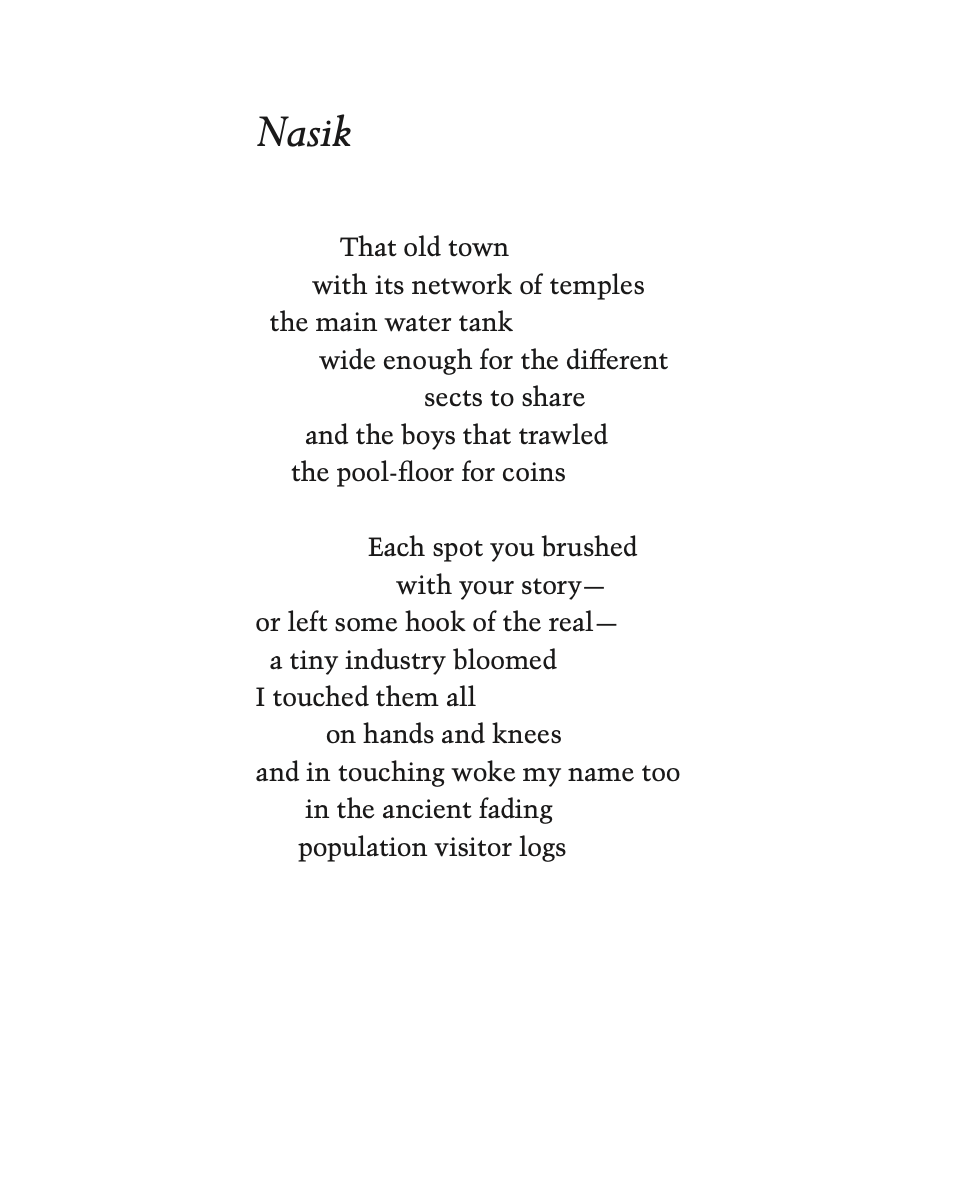
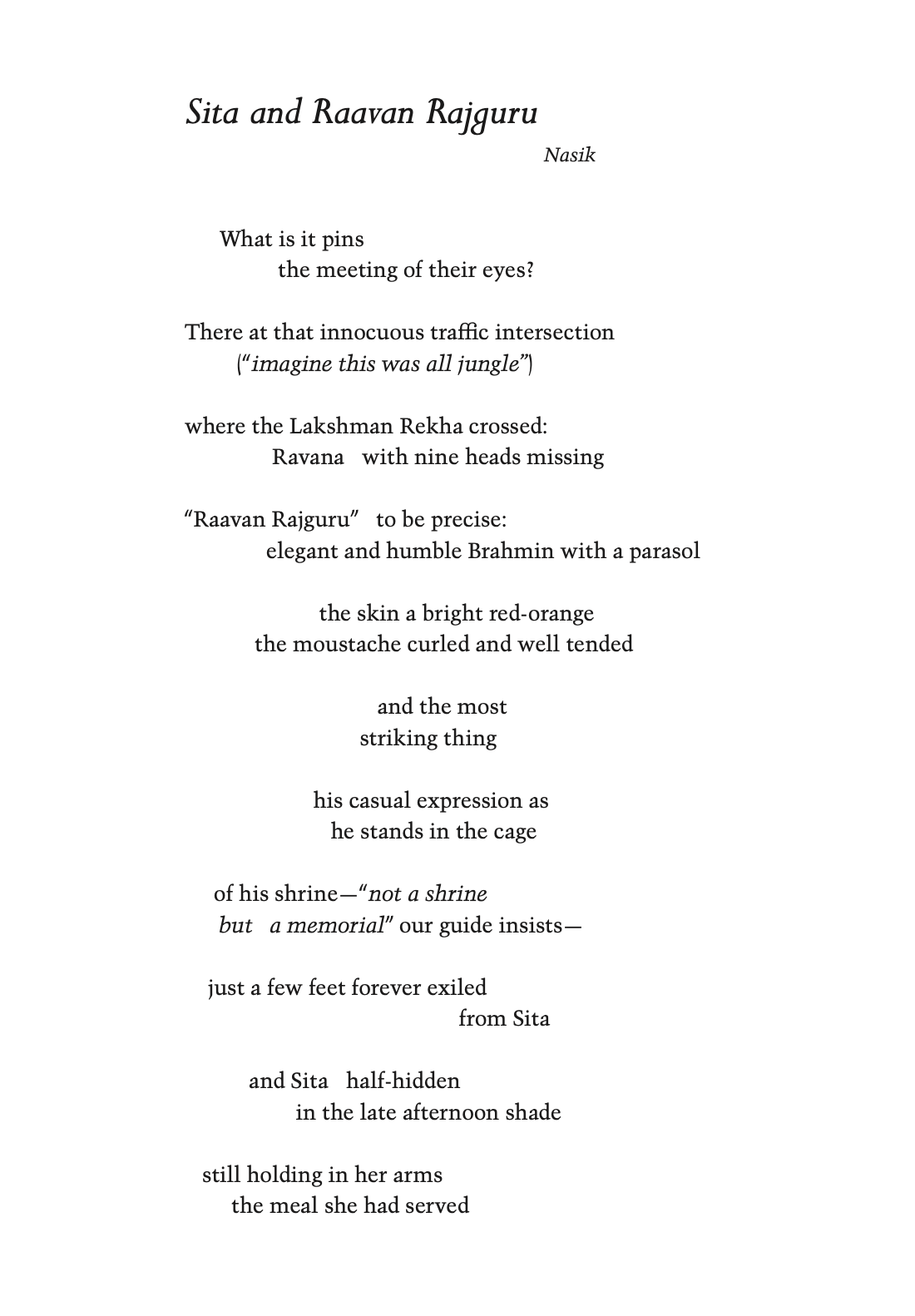
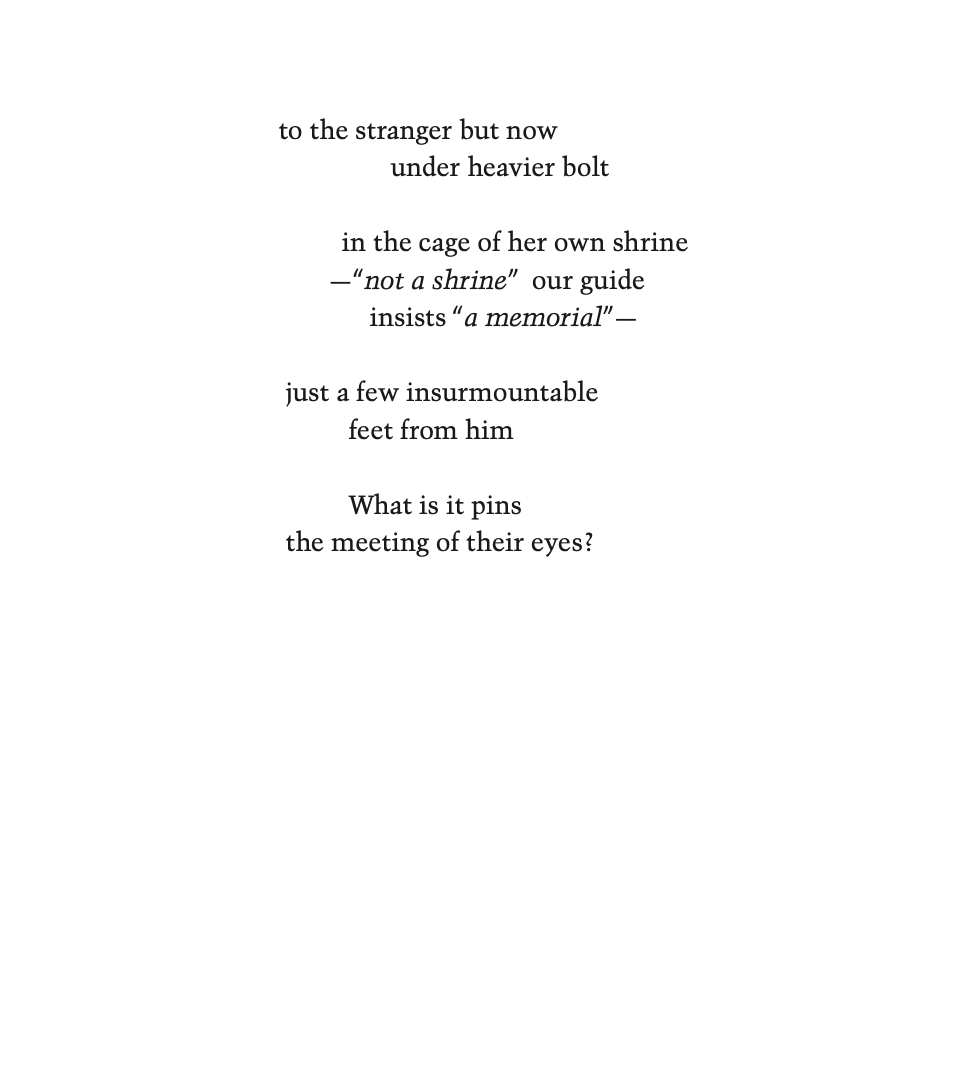
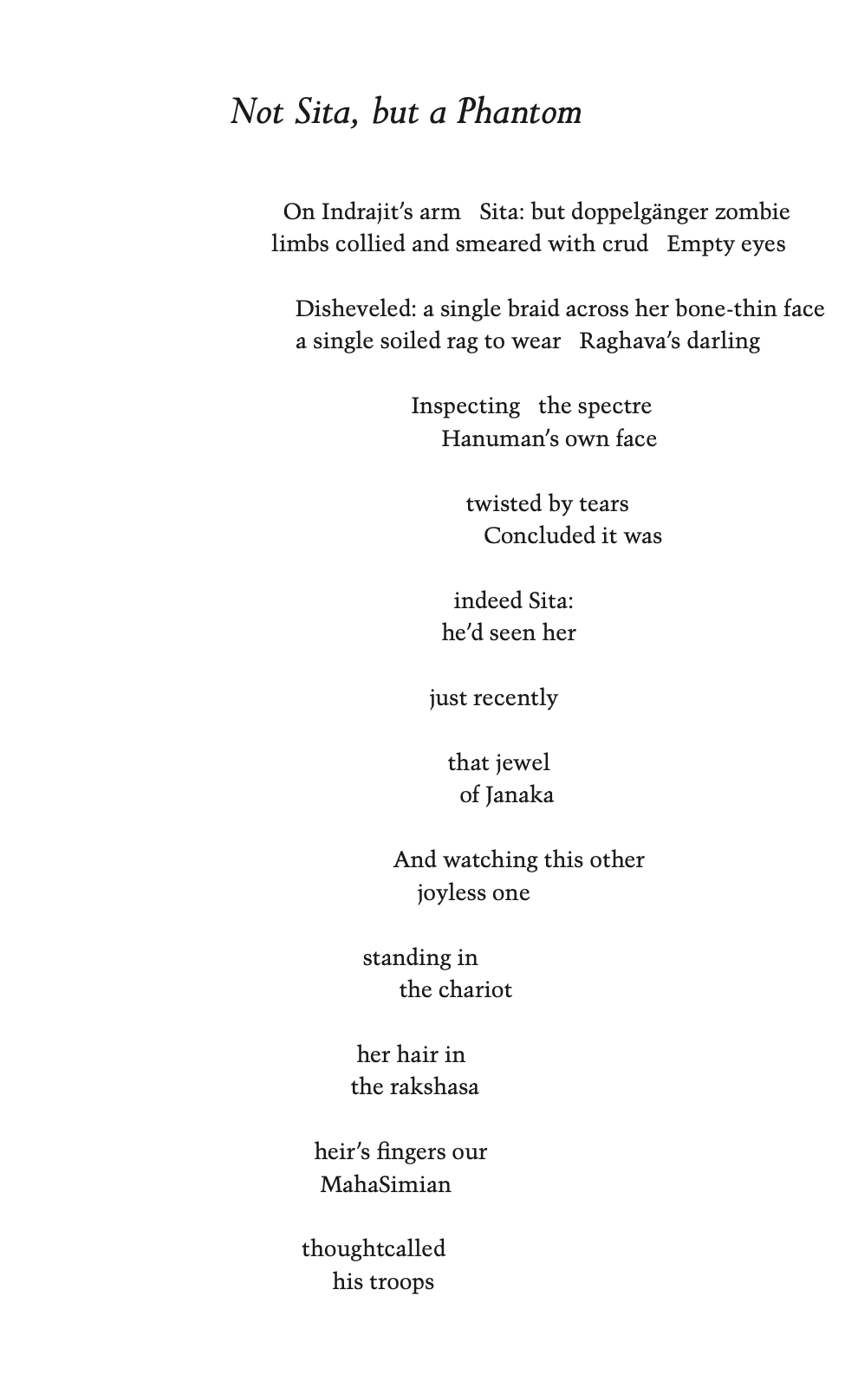
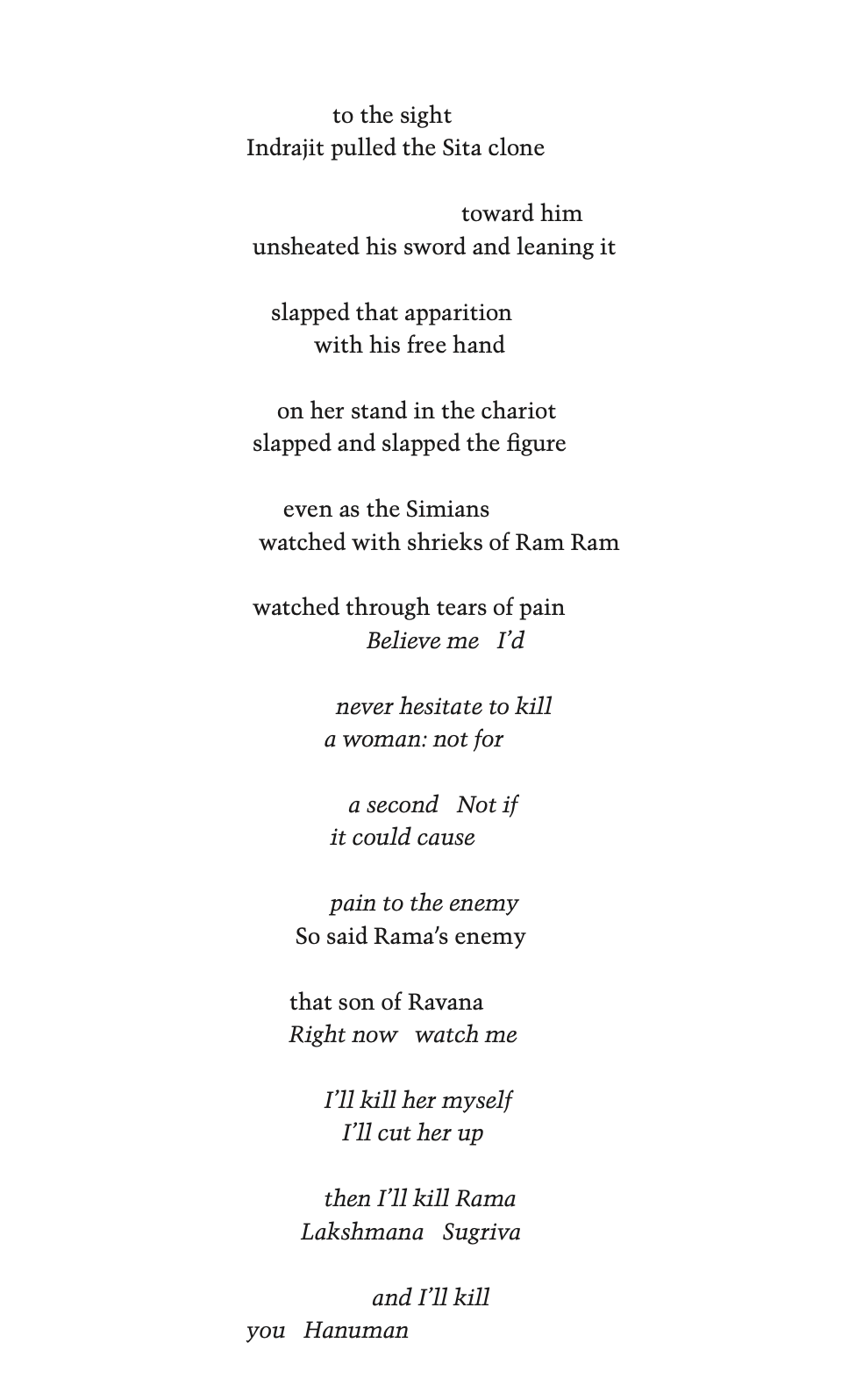
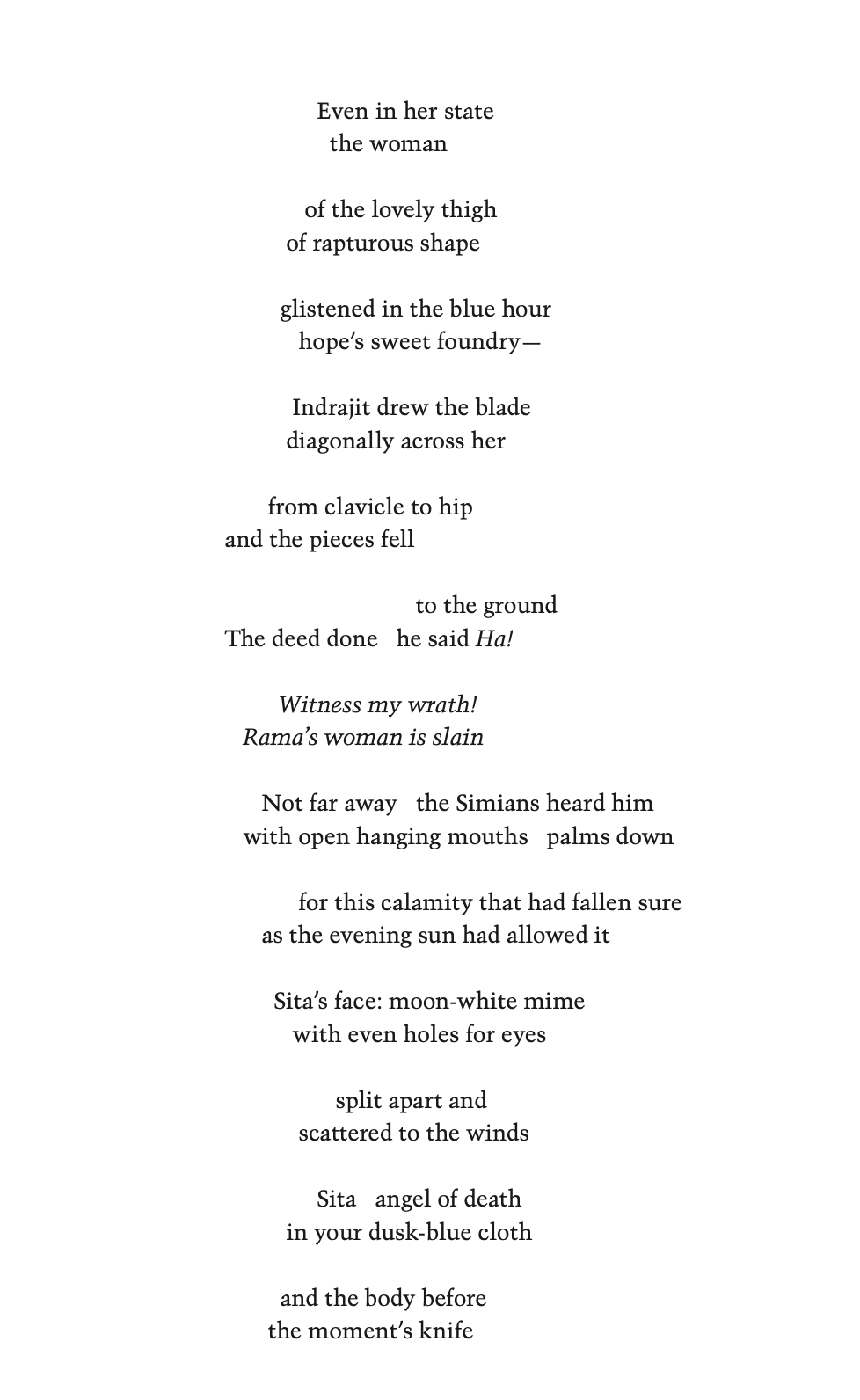
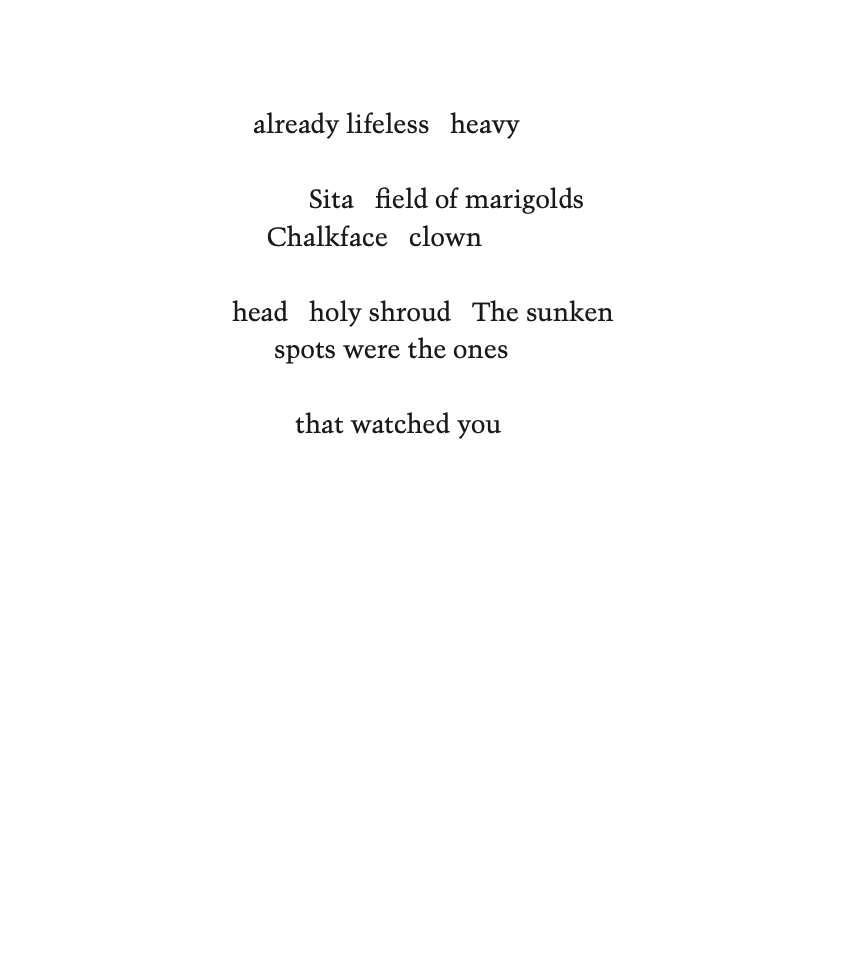
***
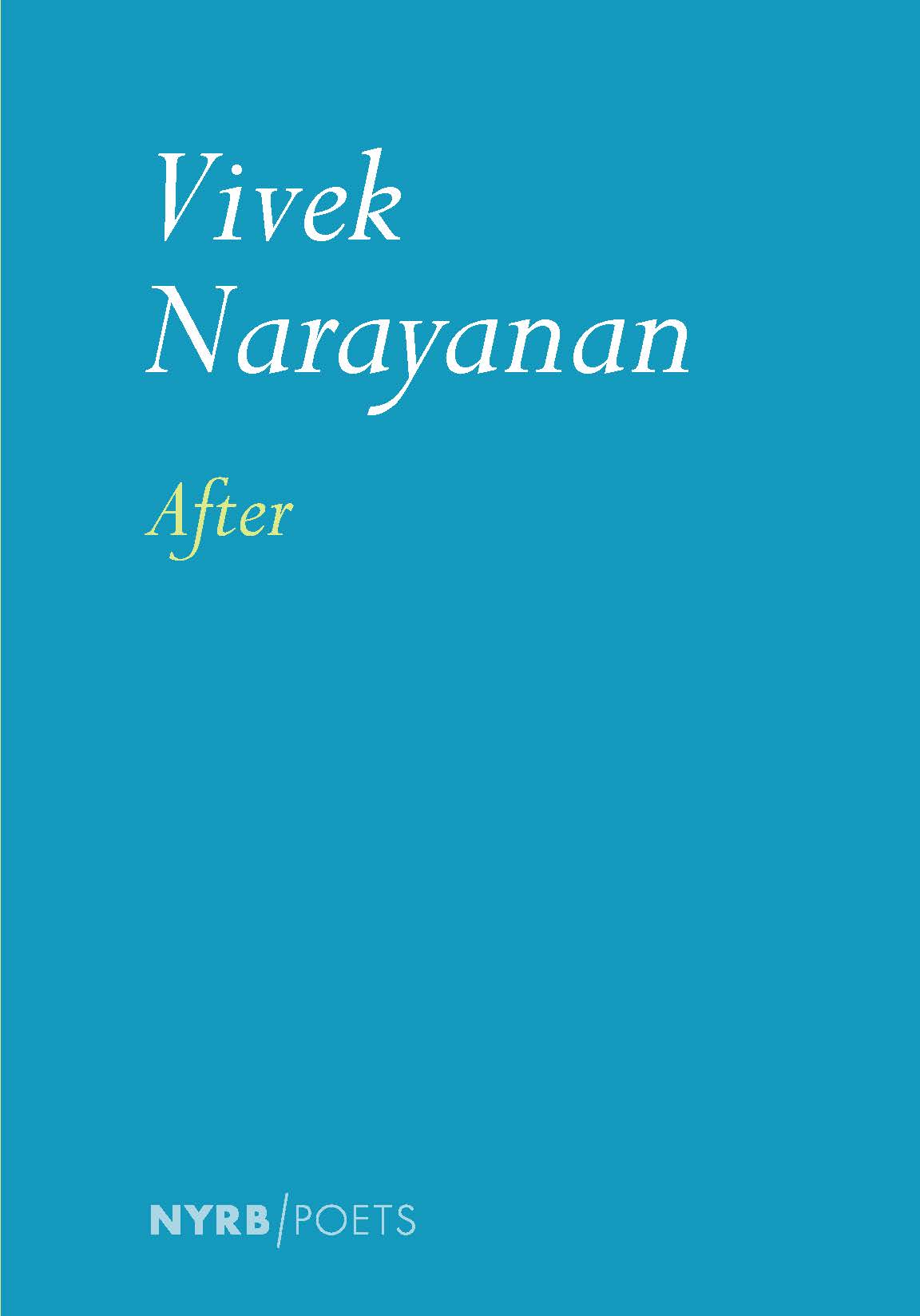
***
After by Vivek Narayanan, New York Review Books
Series: NYRB Poets
ISBN: 9781681376462
Pages: 624
Publication Date: July 19, 2022
***
Vivek Narayanan’s books of poems include Universal Beach, Life and Times of Mr S. His new collection is After (NYRB Poets, 2022). A full-length collection of his selected poems in Swedish translation was published by the Stockholm-based Wahlström & Widstrand in 2015.
Vivek Narayanan was born in India and raised in Zambia. He earned an MA in cultural anthropology from Stanford University, and an MFA in creative writing from Boston University.
He has been a Fellow at the Radcliffe Institute, Harvard University (2013-14) and a Cullman Fellow at the New York Public Library (2015-16). His poems, stories, translations and critical essays have appeared in journals like The Paris Review, Chimurenga Chronic, Granta.com, Poetry Review (UK), Modern Poetry in Translation, Harvard Review, Agni, The Caribbean Review of Books and elsewhere, as well as in anthologies like The Penguin Book of the Prose Poem and The Bloodaxe Book of Contemporary Indian Poetry. Narayanan is also a member of Poetry Daily’s editorial board. He was the Co-editor of Almost Island, an India-based international literary journal from 2007-2019. He teaches at George Mason University in Virginia.

